Anatomy and Physiology - Assignment
VerifiedAdded on 2020/12/18
|13
|3527
|337
AI Summary
Contribute Materials
Your contribution can guide someone’s learning journey. Share your
documents today.
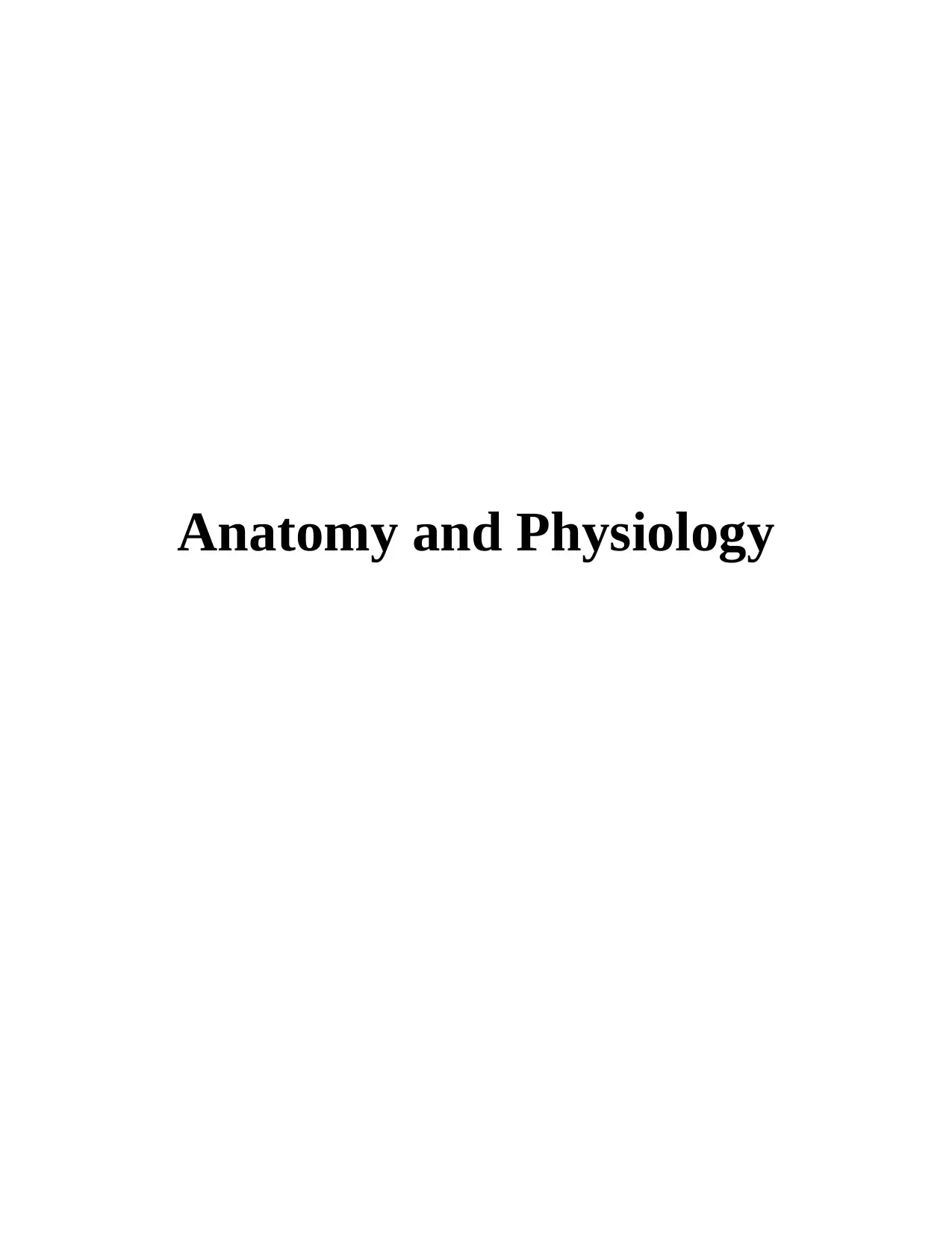
Anatomy and Physiology
Secure Best Marks with AI Grader
Need help grading? Try our AI Grader for instant feedback on your assignments.
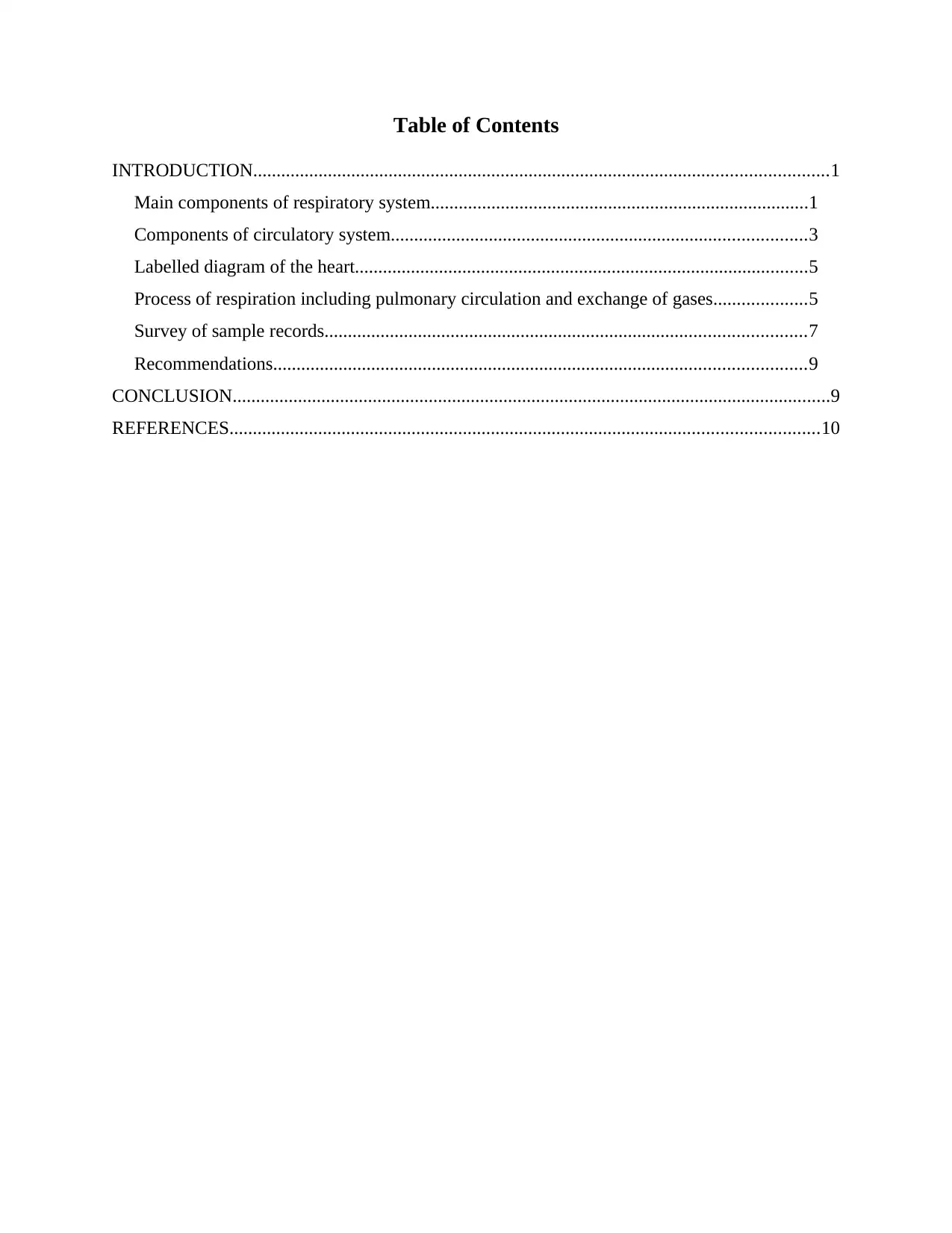
Table of Contents
INTRODUCTION...........................................................................................................................1
Main components of respiratory system.................................................................................1
Components of circulatory system.........................................................................................3
Labelled diagram of the heart.................................................................................................5
Process of respiration including pulmonary circulation and exchange of gases....................5
Survey of sample records.......................................................................................................7
Recommendations..................................................................................................................9
CONCLUSION................................................................................................................................9
REFERENCES..............................................................................................................................10
INTRODUCTION...........................................................................................................................1
Main components of respiratory system.................................................................................1
Components of circulatory system.........................................................................................3
Labelled diagram of the heart.................................................................................................5
Process of respiration including pulmonary circulation and exchange of gases....................5
Survey of sample records.......................................................................................................7
Recommendations..................................................................................................................9
CONCLUSION................................................................................................................................9
REFERENCES..............................................................................................................................10

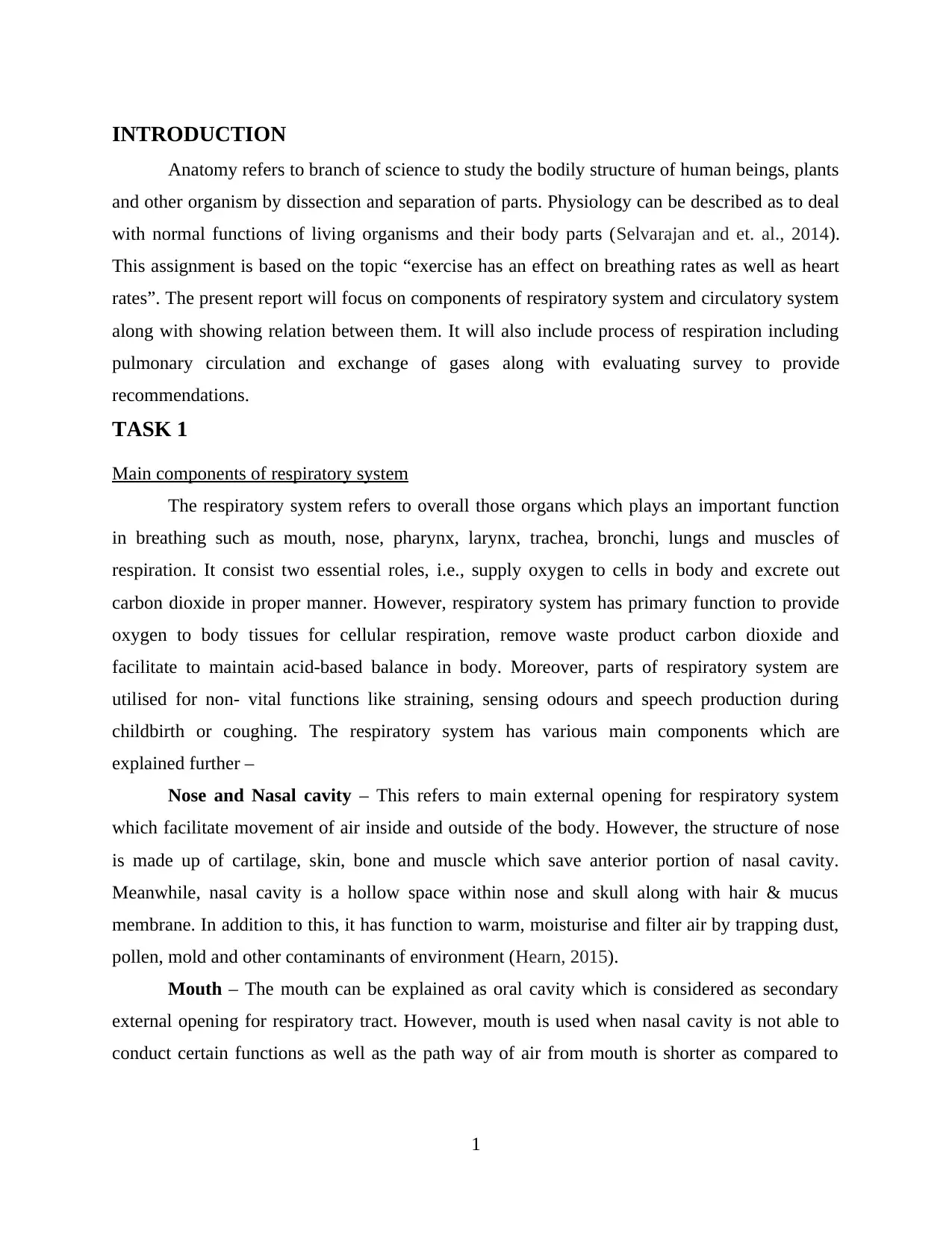
INTRODUCTION
Anatomy refers to branch of science to study the bodily structure of human beings, plants
and other organism by dissection and separation of parts. Physiology can be described as to deal
with normal functions of living organisms and their body parts (Selvarajan and et. al., 2014).
This assignment is based on the topic “exercise has an effect on breathing rates as well as heart
rates”. The present report will focus on components of respiratory system and circulatory system
along with showing relation between them. It will also include process of respiration including
pulmonary circulation and exchange of gases along with evaluating survey to provide
recommendations.
TASK 1
Main components of respiratory system
The respiratory system refers to overall those organs which plays an important function
in breathing such as mouth, nose, pharynx, larynx, trachea, bronchi, lungs and muscles of
respiration. It consist two essential roles, i.e., supply oxygen to cells in body and excrete out
carbon dioxide in proper manner. However, respiratory system has primary function to provide
oxygen to body tissues for cellular respiration, remove waste product carbon dioxide and
facilitate to maintain acid-based balance in body. Moreover, parts of respiratory system are
utilised for non- vital functions like straining, sensing odours and speech production during
childbirth or coughing. The respiratory system has various main components which are
explained further –
Nose and Nasal cavity – This refers to main external opening for respiratory system
which facilitate movement of air inside and outside of the body. However, the structure of nose
is made up of cartilage, skin, bone and muscle which save anterior portion of nasal cavity.
Meanwhile, nasal cavity is a hollow space within nose and skull along with hair & mucus
membrane. In addition to this, it has function to warm, moisturise and filter air by trapping dust,
pollen, mold and other contaminants of environment (Hearn, 2015).
Mouth – The mouth can be explained as oral cavity which is considered as secondary
external opening for respiratory tract. However, mouth is used when nasal cavity is not able to
conduct certain functions as well as the path way of air from mouth is shorter as compared to
1
Anatomy refers to branch of science to study the bodily structure of human beings, plants
and other organism by dissection and separation of parts. Physiology can be described as to deal
with normal functions of living organisms and their body parts (Selvarajan and et. al., 2014).
This assignment is based on the topic “exercise has an effect on breathing rates as well as heart
rates”. The present report will focus on components of respiratory system and circulatory system
along with showing relation between them. It will also include process of respiration including
pulmonary circulation and exchange of gases along with evaluating survey to provide
recommendations.
TASK 1
Main components of respiratory system
The respiratory system refers to overall those organs which plays an important function
in breathing such as mouth, nose, pharynx, larynx, trachea, bronchi, lungs and muscles of
respiration. It consist two essential roles, i.e., supply oxygen to cells in body and excrete out
carbon dioxide in proper manner. However, respiratory system has primary function to provide
oxygen to body tissues for cellular respiration, remove waste product carbon dioxide and
facilitate to maintain acid-based balance in body. Moreover, parts of respiratory system are
utilised for non- vital functions like straining, sensing odours and speech production during
childbirth or coughing. The respiratory system has various main components which are
explained further –
Nose and Nasal cavity – This refers to main external opening for respiratory system
which facilitate movement of air inside and outside of the body. However, the structure of nose
is made up of cartilage, skin, bone and muscle which save anterior portion of nasal cavity.
Meanwhile, nasal cavity is a hollow space within nose and skull along with hair & mucus
membrane. In addition to this, it has function to warm, moisturise and filter air by trapping dust,
pollen, mold and other contaminants of environment (Hearn, 2015).
Mouth – The mouth can be explained as oral cavity which is considered as secondary
external opening for respiratory tract. However, mouth is used when nasal cavity is not able to
conduct certain functions as well as the path way of air from mouth is shorter as compared to
1
Secure Best Marks with AI Grader
Need help grading? Try our AI Grader for instant feedback on your assignments.
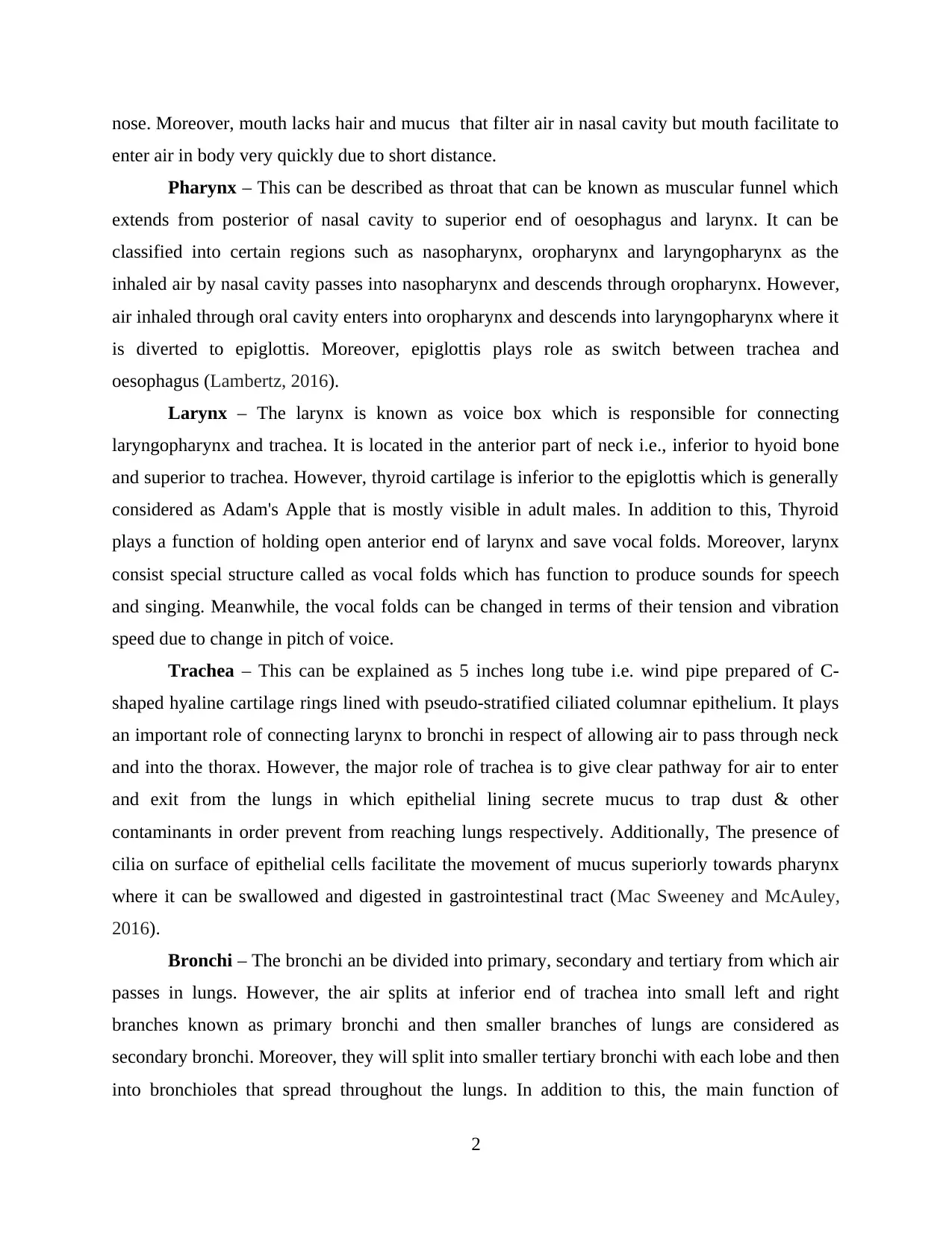
nose. Moreover, mouth lacks hair and mucus that filter air in nasal cavity but mouth facilitate to
enter air in body very quickly due to short distance.
Pharynx – This can be described as throat that can be known as muscular funnel which
extends from posterior of nasal cavity to superior end of oesophagus and larynx. It can be
classified into certain regions such as nasopharynx, oropharynx and laryngopharynx as the
inhaled air by nasal cavity passes into nasopharynx and descends through oropharynx. However,
air inhaled through oral cavity enters into oropharynx and descends into laryngopharynx where it
is diverted to epiglottis. Moreover, epiglottis plays role as switch between trachea and
oesophagus (Lambertz, 2016).
Larynx – The larynx is known as voice box which is responsible for connecting
laryngopharynx and trachea. It is located in the anterior part of neck i.e., inferior to hyoid bone
and superior to trachea. However, thyroid cartilage is inferior to the epiglottis which is generally
considered as Adam's Apple that is mostly visible in adult males. In addition to this, Thyroid
plays a function of holding open anterior end of larynx and save vocal folds. Moreover, larynx
consist special structure called as vocal folds which has function to produce sounds for speech
and singing. Meanwhile, the vocal folds can be changed in terms of their tension and vibration
speed due to change in pitch of voice.
Trachea – This can be explained as 5 inches long tube i.e. wind pipe prepared of C-
shaped hyaline cartilage rings lined with pseudo-stratified ciliated columnar epithelium. It plays
an important role of connecting larynx to bronchi in respect of allowing air to pass through neck
and into the thorax. However, the major role of trachea is to give clear pathway for air to enter
and exit from the lungs in which epithelial lining secrete mucus to trap dust & other
contaminants in order prevent from reaching lungs respectively. Additionally, The presence of
cilia on surface of epithelial cells facilitate the movement of mucus superiorly towards pharynx
where it can be swallowed and digested in gastrointestinal tract (Mac Sweeney and McAuley,
2016).
Bronchi – The bronchi an be divided into primary, secondary and tertiary from which air
passes in lungs. However, the air splits at inferior end of trachea into small left and right
branches known as primary bronchi and then smaller branches of lungs are considered as
secondary bronchi. Moreover, they will split into smaller tertiary bronchi with each lobe and then
into bronchioles that spread throughout the lungs. In addition to this, the main function of
2
enter air in body very quickly due to short distance.
Pharynx – This can be described as throat that can be known as muscular funnel which
extends from posterior of nasal cavity to superior end of oesophagus and larynx. It can be
classified into certain regions such as nasopharynx, oropharynx and laryngopharynx as the
inhaled air by nasal cavity passes into nasopharynx and descends through oropharynx. However,
air inhaled through oral cavity enters into oropharynx and descends into laryngopharynx where it
is diverted to epiglottis. Moreover, epiglottis plays role as switch between trachea and
oesophagus (Lambertz, 2016).
Larynx – The larynx is known as voice box which is responsible for connecting
laryngopharynx and trachea. It is located in the anterior part of neck i.e., inferior to hyoid bone
and superior to trachea. However, thyroid cartilage is inferior to the epiglottis which is generally
considered as Adam's Apple that is mostly visible in adult males. In addition to this, Thyroid
plays a function of holding open anterior end of larynx and save vocal folds. Moreover, larynx
consist special structure called as vocal folds which has function to produce sounds for speech
and singing. Meanwhile, the vocal folds can be changed in terms of their tension and vibration
speed due to change in pitch of voice.
Trachea – This can be explained as 5 inches long tube i.e. wind pipe prepared of C-
shaped hyaline cartilage rings lined with pseudo-stratified ciliated columnar epithelium. It plays
an important role of connecting larynx to bronchi in respect of allowing air to pass through neck
and into the thorax. However, the major role of trachea is to give clear pathway for air to enter
and exit from the lungs in which epithelial lining secrete mucus to trap dust & other
contaminants in order prevent from reaching lungs respectively. Additionally, The presence of
cilia on surface of epithelial cells facilitate the movement of mucus superiorly towards pharynx
where it can be swallowed and digested in gastrointestinal tract (Mac Sweeney and McAuley,
2016).
Bronchi – The bronchi an be divided into primary, secondary and tertiary from which air
passes in lungs. However, the air splits at inferior end of trachea into small left and right
branches known as primary bronchi and then smaller branches of lungs are considered as
secondary bronchi. Moreover, they will split into smaller tertiary bronchi with each lobe and then
into bronchioles that spread throughout the lungs. In addition to this, the main function of
2
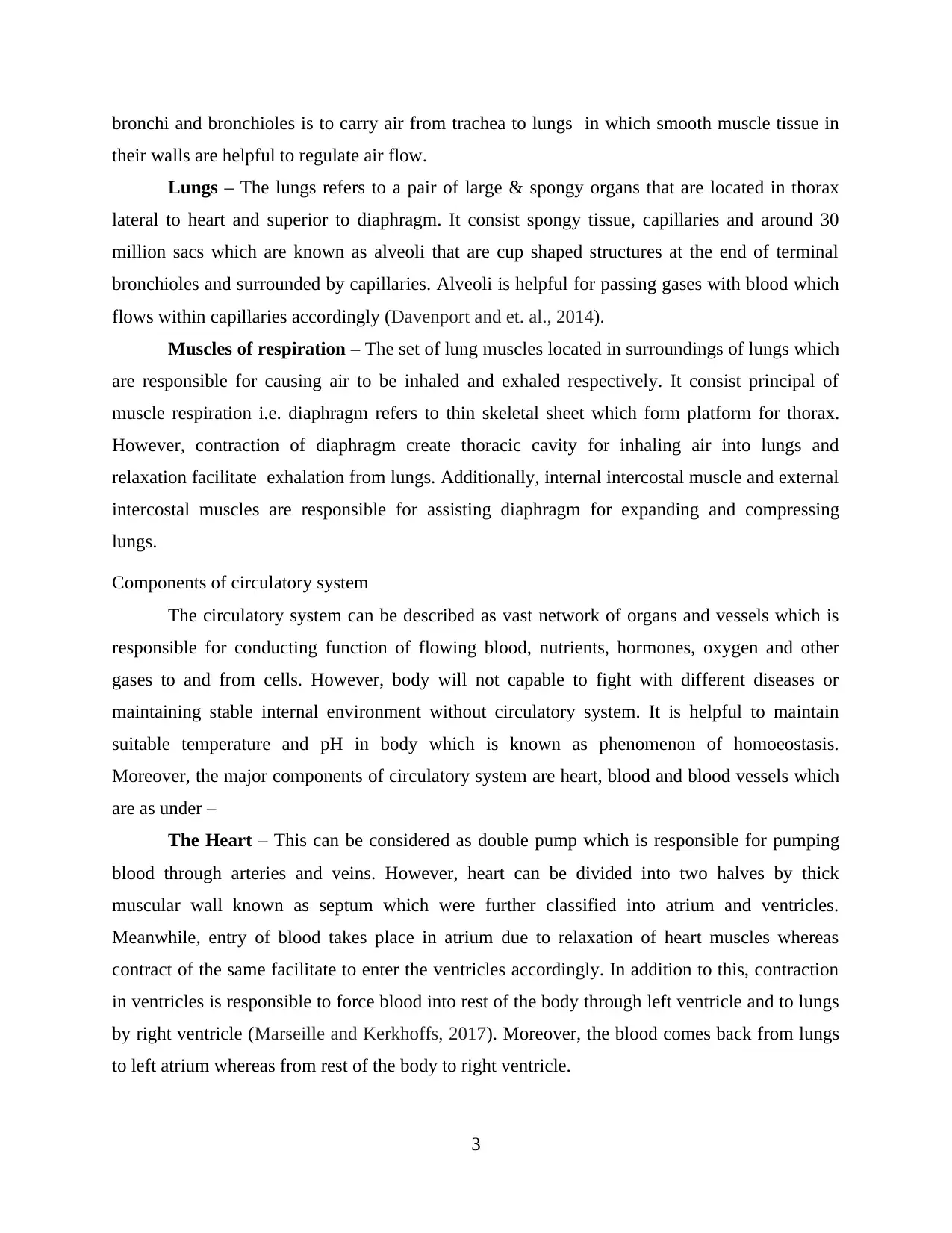
bronchi and bronchioles is to carry air from trachea to lungs in which smooth muscle tissue in
their walls are helpful to regulate air flow.
Lungs – The lungs refers to a pair of large & spongy organs that are located in thorax
lateral to heart and superior to diaphragm. It consist spongy tissue, capillaries and around 30
million sacs which are known as alveoli that are cup shaped structures at the end of terminal
bronchioles and surrounded by capillaries. Alveoli is helpful for passing gases with blood which
flows within capillaries accordingly (Davenport and et. al., 2014).
Muscles of respiration – The set of lung muscles located in surroundings of lungs which
are responsible for causing air to be inhaled and exhaled respectively. It consist principal of
muscle respiration i.e. diaphragm refers to thin skeletal sheet which form platform for thorax.
However, contraction of diaphragm create thoracic cavity for inhaling air into lungs and
relaxation facilitate exhalation from lungs. Additionally, internal intercostal muscle and external
intercostal muscles are responsible for assisting diaphragm for expanding and compressing
lungs.
Components of circulatory system
The circulatory system can be described as vast network of organs and vessels which is
responsible for conducting function of flowing blood, nutrients, hormones, oxygen and other
gases to and from cells. However, body will not capable to fight with different diseases or
maintaining stable internal environment without circulatory system. It is helpful to maintain
suitable temperature and pH in body which is known as phenomenon of homoeostasis.
Moreover, the major components of circulatory system are heart, blood and blood vessels which
are as under –
The Heart – This can be considered as double pump which is responsible for pumping
blood through arteries and veins. However, heart can be divided into two halves by thick
muscular wall known as septum which were further classified into atrium and ventricles.
Meanwhile, entry of blood takes place in atrium due to relaxation of heart muscles whereas
contract of the same facilitate to enter the ventricles accordingly. In addition to this, contraction
in ventricles is responsible to force blood into rest of the body through left ventricle and to lungs
by right ventricle (Marseille and Kerkhoffs, 2017). Moreover, the blood comes back from lungs
to left atrium whereas from rest of the body to right ventricle.
3
their walls are helpful to regulate air flow.
Lungs – The lungs refers to a pair of large & spongy organs that are located in thorax
lateral to heart and superior to diaphragm. It consist spongy tissue, capillaries and around 30
million sacs which are known as alveoli that are cup shaped structures at the end of terminal
bronchioles and surrounded by capillaries. Alveoli is helpful for passing gases with blood which
flows within capillaries accordingly (Davenport and et. al., 2014).
Muscles of respiration – The set of lung muscles located in surroundings of lungs which
are responsible for causing air to be inhaled and exhaled respectively. It consist principal of
muscle respiration i.e. diaphragm refers to thin skeletal sheet which form platform for thorax.
However, contraction of diaphragm create thoracic cavity for inhaling air into lungs and
relaxation facilitate exhalation from lungs. Additionally, internal intercostal muscle and external
intercostal muscles are responsible for assisting diaphragm for expanding and compressing
lungs.
Components of circulatory system
The circulatory system can be described as vast network of organs and vessels which is
responsible for conducting function of flowing blood, nutrients, hormones, oxygen and other
gases to and from cells. However, body will not capable to fight with different diseases or
maintaining stable internal environment without circulatory system. It is helpful to maintain
suitable temperature and pH in body which is known as phenomenon of homoeostasis.
Moreover, the major components of circulatory system are heart, blood and blood vessels which
are as under –
The Heart – This can be considered as double pump which is responsible for pumping
blood through arteries and veins. However, heart can be divided into two halves by thick
muscular wall known as septum which were further classified into atrium and ventricles.
Meanwhile, entry of blood takes place in atrium due to relaxation of heart muscles whereas
contract of the same facilitate to enter the ventricles accordingly. In addition to this, contraction
in ventricles is responsible to force blood into rest of the body through left ventricle and to lungs
by right ventricle (Marseille and Kerkhoffs, 2017). Moreover, the blood comes back from lungs
to left atrium whereas from rest of the body to right ventricle.
3
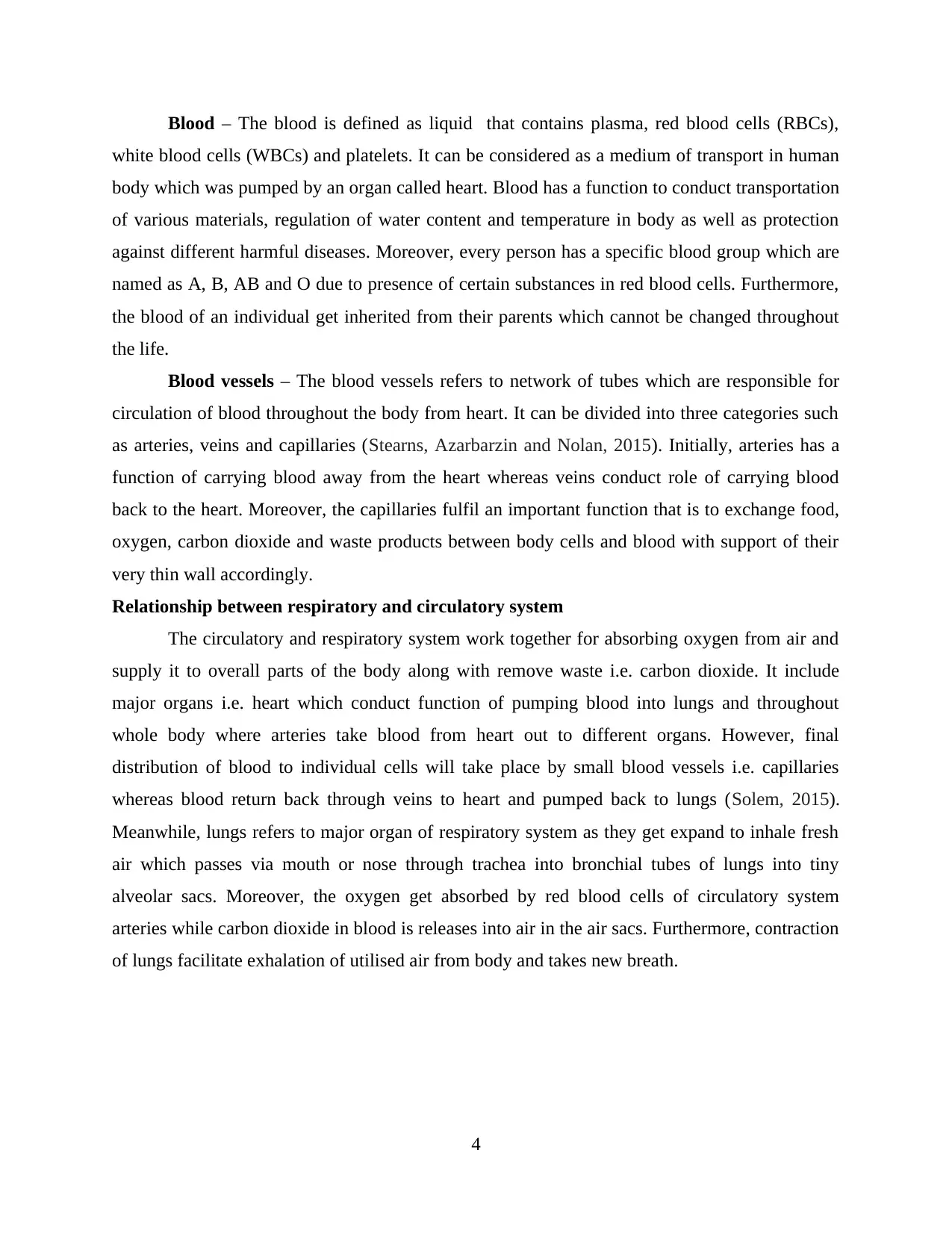
Blood – The blood is defined as liquid that contains plasma, red blood cells (RBCs),
white blood cells (WBCs) and platelets. It can be considered as a medium of transport in human
body which was pumped by an organ called heart. Blood has a function to conduct transportation
of various materials, regulation of water content and temperature in body as well as protection
against different harmful diseases. Moreover, every person has a specific blood group which are
named as A, B, AB and O due to presence of certain substances in red blood cells. Furthermore,
the blood of an individual get inherited from their parents which cannot be changed throughout
the life.
Blood vessels – The blood vessels refers to network of tubes which are responsible for
circulation of blood throughout the body from heart. It can be divided into three categories such
as arteries, veins and capillaries (Stearns, Azarbarzin and Nolan, 2015). Initially, arteries has a
function of carrying blood away from the heart whereas veins conduct role of carrying blood
back to the heart. Moreover, the capillaries fulfil an important function that is to exchange food,
oxygen, carbon dioxide and waste products between body cells and blood with support of their
very thin wall accordingly.
Relationship between respiratory and circulatory system
The circulatory and respiratory system work together for absorbing oxygen from air and
supply it to overall parts of the body along with remove waste i.e. carbon dioxide. It include
major organs i.e. heart which conduct function of pumping blood into lungs and throughout
whole body where arteries take blood from heart out to different organs. However, final
distribution of blood to individual cells will take place by small blood vessels i.e. capillaries
whereas blood return back through veins to heart and pumped back to lungs (Solem, 2015).
Meanwhile, lungs refers to major organ of respiratory system as they get expand to inhale fresh
air which passes via mouth or nose through trachea into bronchial tubes of lungs into tiny
alveolar sacs. Moreover, the oxygen get absorbed by red blood cells of circulatory system
arteries while carbon dioxide in blood is releases into air in the air sacs. Furthermore, contraction
of lungs facilitate exhalation of utilised air from body and takes new breath.
4
white blood cells (WBCs) and platelets. It can be considered as a medium of transport in human
body which was pumped by an organ called heart. Blood has a function to conduct transportation
of various materials, regulation of water content and temperature in body as well as protection
against different harmful diseases. Moreover, every person has a specific blood group which are
named as A, B, AB and O due to presence of certain substances in red blood cells. Furthermore,
the blood of an individual get inherited from their parents which cannot be changed throughout
the life.
Blood vessels – The blood vessels refers to network of tubes which are responsible for
circulation of blood throughout the body from heart. It can be divided into three categories such
as arteries, veins and capillaries (Stearns, Azarbarzin and Nolan, 2015). Initially, arteries has a
function of carrying blood away from the heart whereas veins conduct role of carrying blood
back to the heart. Moreover, the capillaries fulfil an important function that is to exchange food,
oxygen, carbon dioxide and waste products between body cells and blood with support of their
very thin wall accordingly.
Relationship between respiratory and circulatory system
The circulatory and respiratory system work together for absorbing oxygen from air and
supply it to overall parts of the body along with remove waste i.e. carbon dioxide. It include
major organs i.e. heart which conduct function of pumping blood into lungs and throughout
whole body where arteries take blood from heart out to different organs. However, final
distribution of blood to individual cells will take place by small blood vessels i.e. capillaries
whereas blood return back through veins to heart and pumped back to lungs (Solem, 2015).
Meanwhile, lungs refers to major organ of respiratory system as they get expand to inhale fresh
air which passes via mouth or nose through trachea into bronchial tubes of lungs into tiny
alveolar sacs. Moreover, the oxygen get absorbed by red blood cells of circulatory system
arteries while carbon dioxide in blood is releases into air in the air sacs. Furthermore, contraction
of lungs facilitate exhalation of utilised air from body and takes new breath.
4
Paraphrase This Document
Need a fresh take? Get an instant paraphrase of this document with our AI Paraphraser
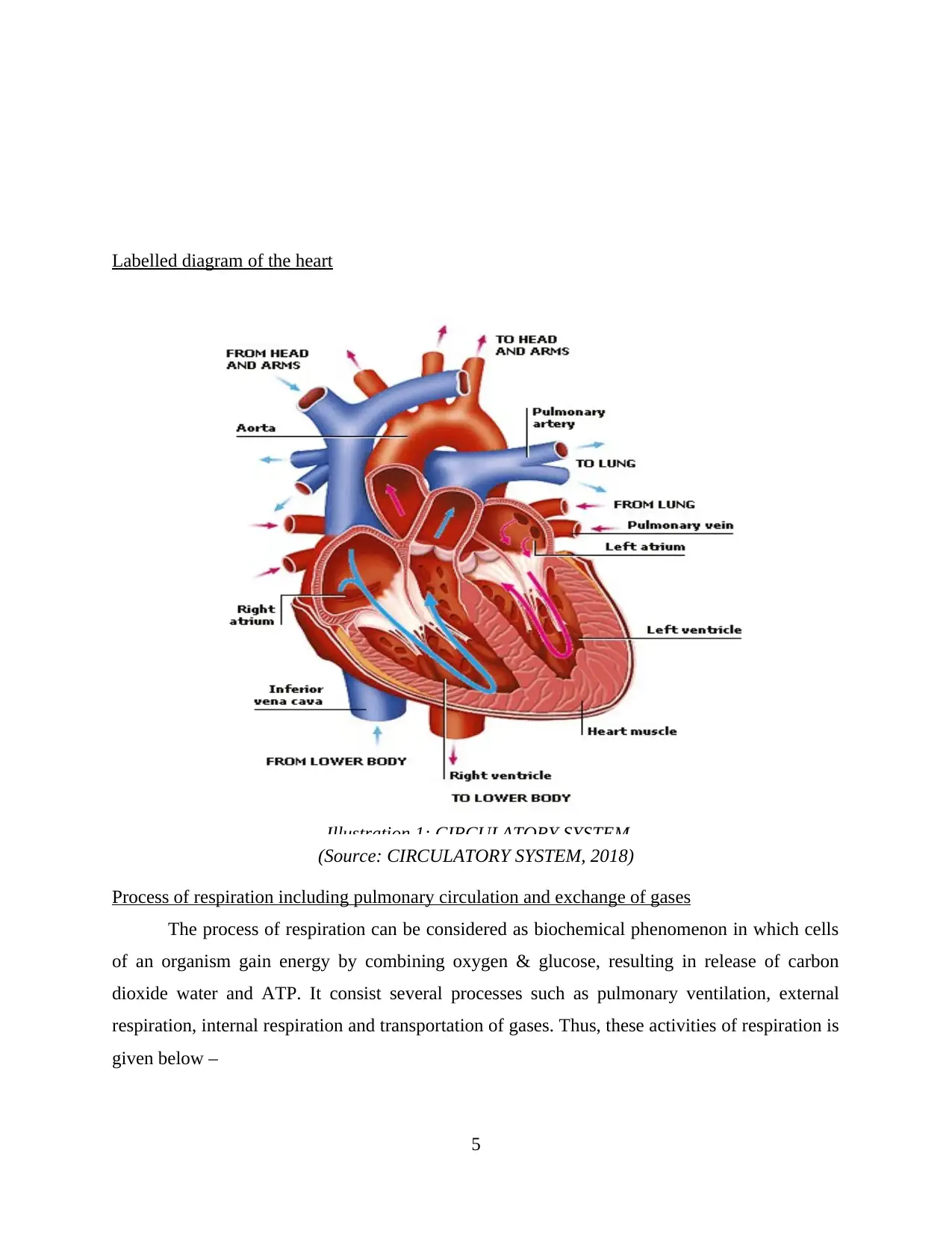
Labelled diagram of the heart
(Source: CIRCULATORY SYSTEM, 2018)
Process of respiration including pulmonary circulation and exchange of gases
The process of respiration can be considered as biochemical phenomenon in which cells
of an organism gain energy by combining oxygen & glucose, resulting in release of carbon
dioxide water and ATP. It consist several processes such as pulmonary ventilation, external
respiration, internal respiration and transportation of gases. Thus, these activities of respiration is
given below –
5
Illustration 1: CIRCULATORY SYSTEM
(Source: CIRCULATORY SYSTEM, 2018)
Process of respiration including pulmonary circulation and exchange of gases
The process of respiration can be considered as biochemical phenomenon in which cells
of an organism gain energy by combining oxygen & glucose, resulting in release of carbon
dioxide water and ATP. It consist several processes such as pulmonary ventilation, external
respiration, internal respiration and transportation of gases. Thus, these activities of respiration is
given below –
5
Illustration 1: CIRCULATORY SYSTEM
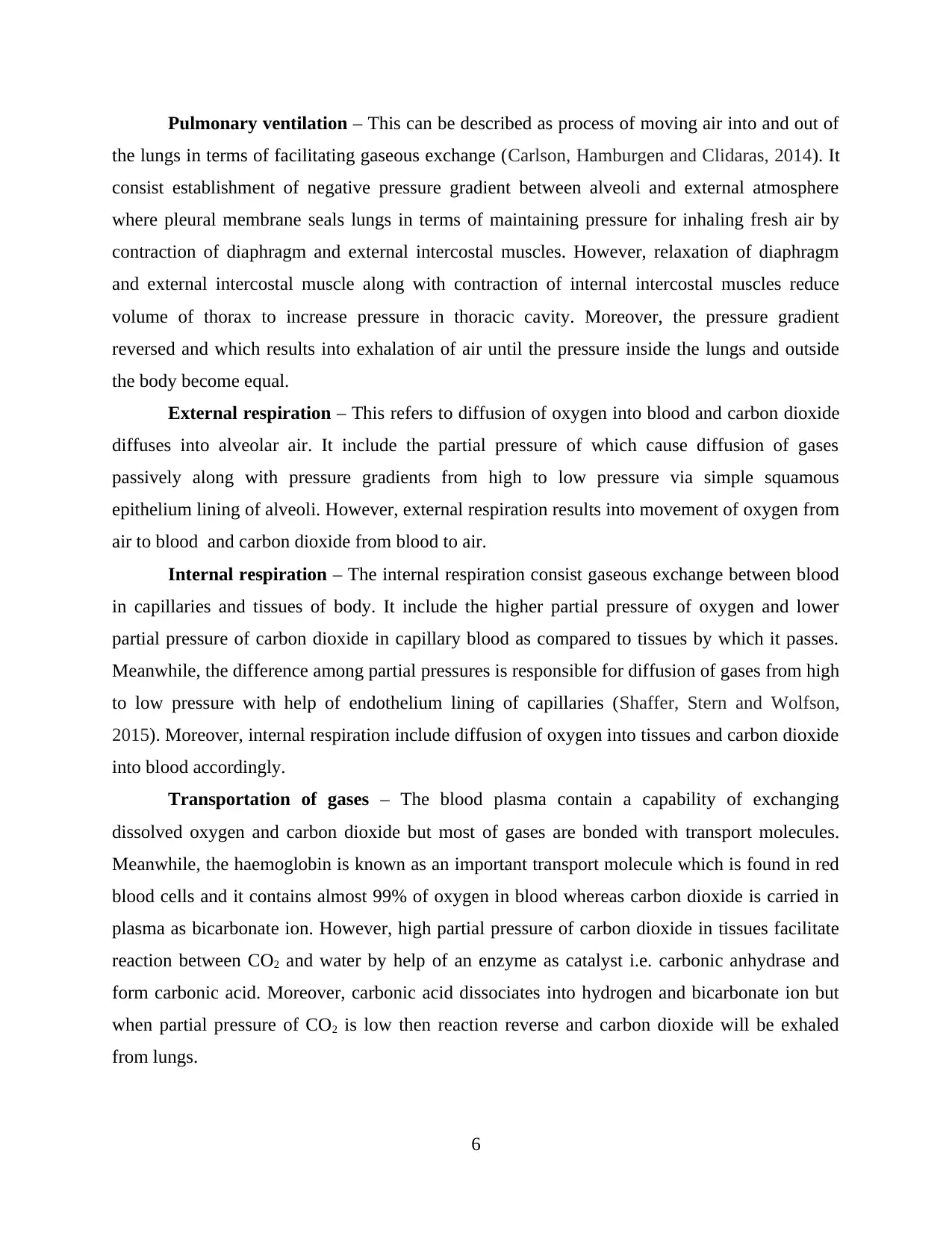
Pulmonary ventilation – This can be described as process of moving air into and out of
the lungs in terms of facilitating gaseous exchange (Carlson, Hamburgen and Clidaras, 2014). It
consist establishment of negative pressure gradient between alveoli and external atmosphere
where pleural membrane seals lungs in terms of maintaining pressure for inhaling fresh air by
contraction of diaphragm and external intercostal muscles. However, relaxation of diaphragm
and external intercostal muscle along with contraction of internal intercostal muscles reduce
volume of thorax to increase pressure in thoracic cavity. Moreover, the pressure gradient
reversed and which results into exhalation of air until the pressure inside the lungs and outside
the body become equal.
External respiration – This refers to diffusion of oxygen into blood and carbon dioxide
diffuses into alveolar air. It include the partial pressure of which cause diffusion of gases
passively along with pressure gradients from high to low pressure via simple squamous
epithelium lining of alveoli. However, external respiration results into movement of oxygen from
air to blood and carbon dioxide from blood to air.
Internal respiration – The internal respiration consist gaseous exchange between blood
in capillaries and tissues of body. It include the higher partial pressure of oxygen and lower
partial pressure of carbon dioxide in capillary blood as compared to tissues by which it passes.
Meanwhile, the difference among partial pressures is responsible for diffusion of gases from high
to low pressure with help of endothelium lining of capillaries (Shaffer, Stern and Wolfson,
2015). Moreover, internal respiration include diffusion of oxygen into tissues and carbon dioxide
into blood accordingly.
Transportation of gases – The blood plasma contain a capability of exchanging
dissolved oxygen and carbon dioxide but most of gases are bonded with transport molecules.
Meanwhile, the haemoglobin is known as an important transport molecule which is found in red
blood cells and it contains almost 99% of oxygen in blood whereas carbon dioxide is carried in
plasma as bicarbonate ion. However, high partial pressure of carbon dioxide in tissues facilitate
reaction between CO2 and water by help of an enzyme as catalyst i.e. carbonic anhydrase and
form carbonic acid. Moreover, carbonic acid dissociates into hydrogen and bicarbonate ion but
when partial pressure of CO2 is low then reaction reverse and carbon dioxide will be exhaled
from lungs.
6
the lungs in terms of facilitating gaseous exchange (Carlson, Hamburgen and Clidaras, 2014). It
consist establishment of negative pressure gradient between alveoli and external atmosphere
where pleural membrane seals lungs in terms of maintaining pressure for inhaling fresh air by
contraction of diaphragm and external intercostal muscles. However, relaxation of diaphragm
and external intercostal muscle along with contraction of internal intercostal muscles reduce
volume of thorax to increase pressure in thoracic cavity. Moreover, the pressure gradient
reversed and which results into exhalation of air until the pressure inside the lungs and outside
the body become equal.
External respiration – This refers to diffusion of oxygen into blood and carbon dioxide
diffuses into alveolar air. It include the partial pressure of which cause diffusion of gases
passively along with pressure gradients from high to low pressure via simple squamous
epithelium lining of alveoli. However, external respiration results into movement of oxygen from
air to blood and carbon dioxide from blood to air.
Internal respiration – The internal respiration consist gaseous exchange between blood
in capillaries and tissues of body. It include the higher partial pressure of oxygen and lower
partial pressure of carbon dioxide in capillary blood as compared to tissues by which it passes.
Meanwhile, the difference among partial pressures is responsible for diffusion of gases from high
to low pressure with help of endothelium lining of capillaries (Shaffer, Stern and Wolfson,
2015). Moreover, internal respiration include diffusion of oxygen into tissues and carbon dioxide
into blood accordingly.
Transportation of gases – The blood plasma contain a capability of exchanging
dissolved oxygen and carbon dioxide but most of gases are bonded with transport molecules.
Meanwhile, the haemoglobin is known as an important transport molecule which is found in red
blood cells and it contains almost 99% of oxygen in blood whereas carbon dioxide is carried in
plasma as bicarbonate ion. However, high partial pressure of carbon dioxide in tissues facilitate
reaction between CO2 and water by help of an enzyme as catalyst i.e. carbonic anhydrase and
form carbonic acid. Moreover, carbonic acid dissociates into hydrogen and bicarbonate ion but
when partial pressure of CO2 is low then reaction reverse and carbon dioxide will be exhaled
from lungs.
6
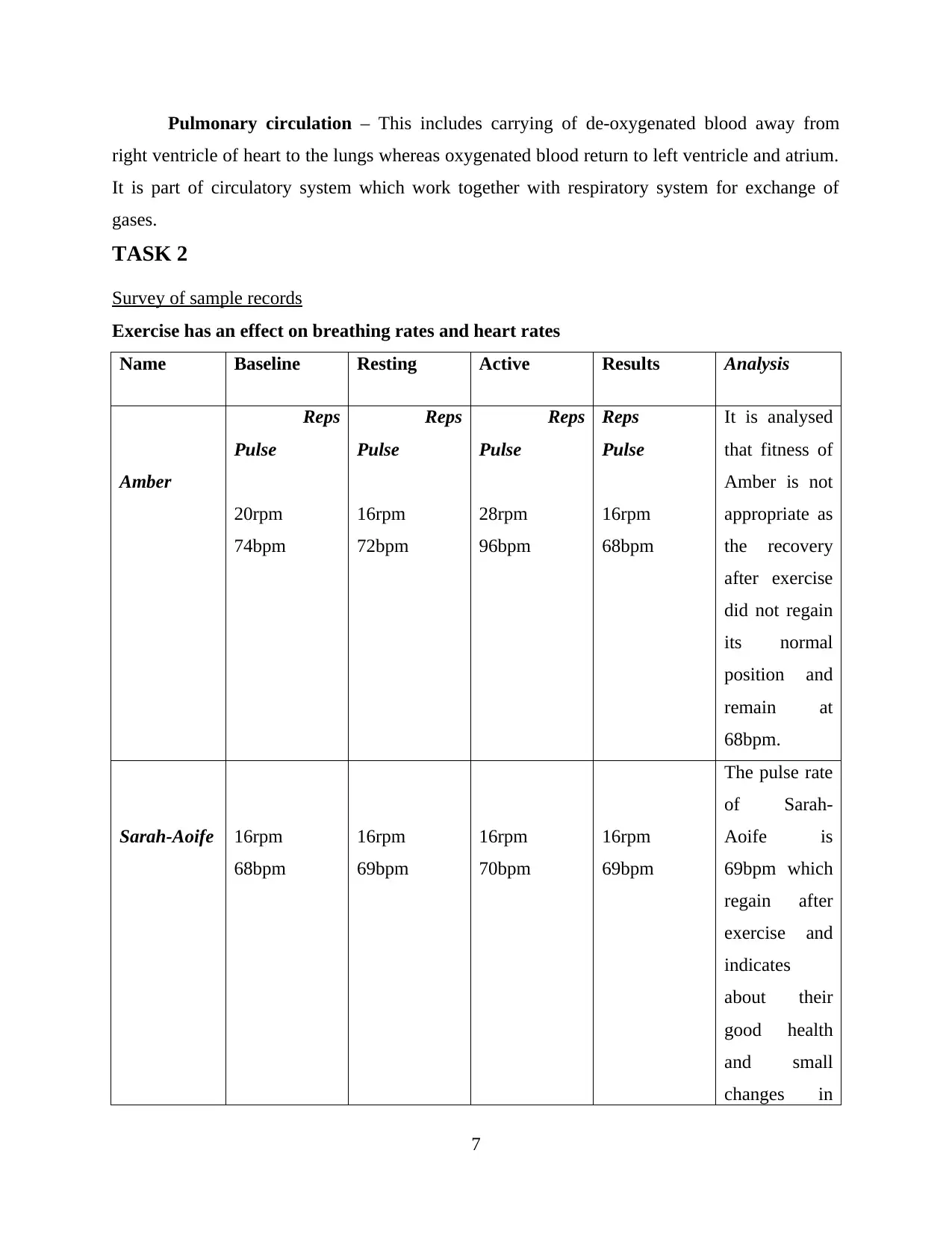
Pulmonary circulation – This includes carrying of de-oxygenated blood away from
right ventricle of heart to the lungs whereas oxygenated blood return to left ventricle and atrium.
It is part of circulatory system which work together with respiratory system for exchange of
gases.
TASK 2
Survey of sample records
Exercise has an effect on breathing rates and heart rates
Name Baseline Resting Active Results Analysis
Amber
Reps
Pulse
20rpm
74bpm
Reps
Pulse
16rpm
72bpm
Reps
Pulse
28rpm
96bpm
Reps
Pulse
16rpm
68bpm
It is analysed
that fitness of
Amber is not
appropriate as
the recovery
after exercise
did not regain
its normal
position and
remain at
68bpm.
Sarah-Aoife 16rpm
68bpm
16rpm
69bpm
16rpm
70bpm
16rpm
69bpm
The pulse rate
of Sarah-
Aoife is
69bpm which
regain after
exercise and
indicates
about their
good health
and small
changes in
7
right ventricle of heart to the lungs whereas oxygenated blood return to left ventricle and atrium.
It is part of circulatory system which work together with respiratory system for exchange of
gases.
TASK 2
Survey of sample records
Exercise has an effect on breathing rates and heart rates
Name Baseline Resting Active Results Analysis
Amber
Reps
Pulse
20rpm
74bpm
Reps
Pulse
16rpm
72bpm
Reps
Pulse
28rpm
96bpm
Reps
Pulse
16rpm
68bpm
It is analysed
that fitness of
Amber is not
appropriate as
the recovery
after exercise
did not regain
its normal
position and
remain at
68bpm.
Sarah-Aoife 16rpm
68bpm
16rpm
69bpm
16rpm
70bpm
16rpm
69bpm
The pulse rate
of Sarah-
Aoife is
69bpm which
regain after
exercise and
indicates
about their
good health
and small
changes in
7
Secure Best Marks with AI Grader
Need help grading? Try our AI Grader for instant feedback on your assignments.
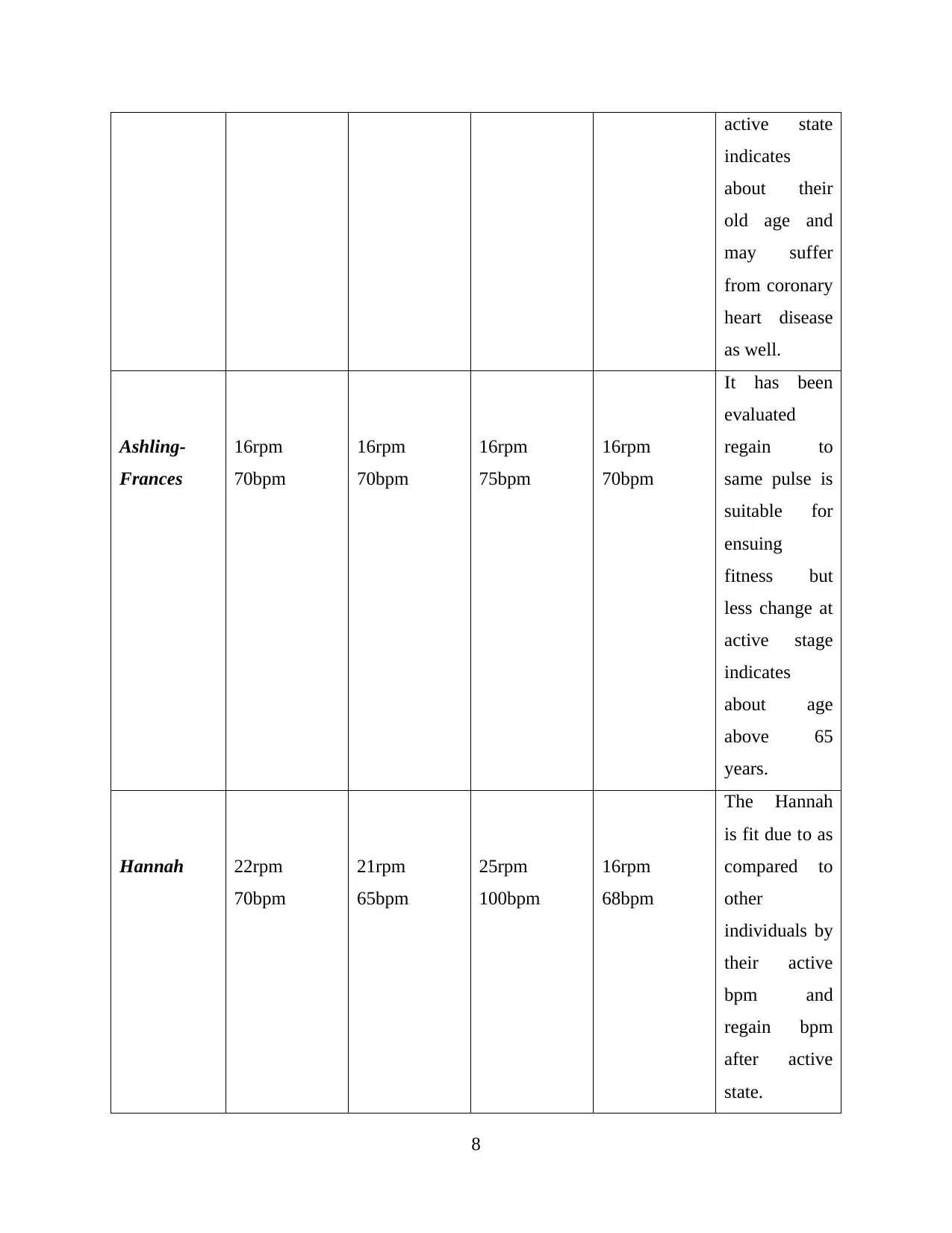
active state
indicates
about their
old age and
may suffer
from coronary
heart disease
as well.
Ashling-
Frances
16rpm
70bpm
16rpm
70bpm
16rpm
75bpm
16rpm
70bpm
It has been
evaluated
regain to
same pulse is
suitable for
ensuing
fitness but
less change at
active stage
indicates
about age
above 65
years.
Hannah 22rpm
70bpm
21rpm
65bpm
25rpm
100bpm
16rpm
68bpm
The Hannah
is fit due to as
compared to
other
individuals by
their active
bpm and
regain bpm
after active
state.
8
indicates
about their
old age and
may suffer
from coronary
heart disease
as well.
Ashling-
Frances
16rpm
70bpm
16rpm
70bpm
16rpm
75bpm
16rpm
70bpm
It has been
evaluated
regain to
same pulse is
suitable for
ensuing
fitness but
less change at
active stage
indicates
about age
above 65
years.
Hannah 22rpm
70bpm
21rpm
65bpm
25rpm
100bpm
16rpm
68bpm
The Hannah
is fit due to as
compared to
other
individuals by
their active
bpm and
regain bpm
after active
state.
8

Elizabeth 16rpm
76bpm
18rpm
76bpm
24rpm
114bpm
19rpm
80bpm
It is analysed
that Elizabeth
is not fit
because of not
regaining
same to rest
stage bpm
after active
state.
Recommendations
From the above survey, it has been analysed that an individual can be considered as more
fit if they recover their normal pulse rate in less duration of time. It is recommended that an
individual should focus on their pulse rate which facilitate to evaluate present health problem.
However, it is analysed that normal resting heart rate is between 60 to 100 beats per minute
(bpm) which is required to be regained after active state or exercise that indicates about
appropriate fitness of an individual. It is suggested that people can determine their health
problem through evaluating their heart rate after work out to take immediate actions. It will
facilitate to analyse issue earlier which is helpful to take medication initially to remain healthy
by avoiding complications. In addition to this, the pulse rate at resting, during exercise and after
active stage defines about fitness of an individual, age and health problem like coronary heart
disease. It is recommended that people should adopt regular exercise and work out in daily
routine which helps to remain healthy and increase stamina.
CONCLUSION
The above report is conclude that anatomy refers to study about body parts and
physiology include functions of body of an organism It include respiratory and circulatory
systems and their relation to perform transportation of oxygen & carbon dioxide in body.
Moreover, it involve main parts of respiratory system such as nose & nasal cavity, mouth,
pharynx, larynx, trachea, bronchi, lung and muscles of respiration. Meanwhile, major
9
76bpm
18rpm
76bpm
24rpm
114bpm
19rpm
80bpm
It is analysed
that Elizabeth
is not fit
because of not
regaining
same to rest
stage bpm
after active
state.
Recommendations
From the above survey, it has been analysed that an individual can be considered as more
fit if they recover their normal pulse rate in less duration of time. It is recommended that an
individual should focus on their pulse rate which facilitate to evaluate present health problem.
However, it is analysed that normal resting heart rate is between 60 to 100 beats per minute
(bpm) which is required to be regained after active state or exercise that indicates about
appropriate fitness of an individual. It is suggested that people can determine their health
problem through evaluating their heart rate after work out to take immediate actions. It will
facilitate to analyse issue earlier which is helpful to take medication initially to remain healthy
by avoiding complications. In addition to this, the pulse rate at resting, during exercise and after
active stage defines about fitness of an individual, age and health problem like coronary heart
disease. It is recommended that people should adopt regular exercise and work out in daily
routine which helps to remain healthy and increase stamina.
CONCLUSION
The above report is conclude that anatomy refers to study about body parts and
physiology include functions of body of an organism It include respiratory and circulatory
systems and their relation to perform transportation of oxygen & carbon dioxide in body.
Moreover, it involve main parts of respiratory system such as nose & nasal cavity, mouth,
pharynx, larynx, trachea, bronchi, lung and muscles of respiration. Meanwhile, major
9
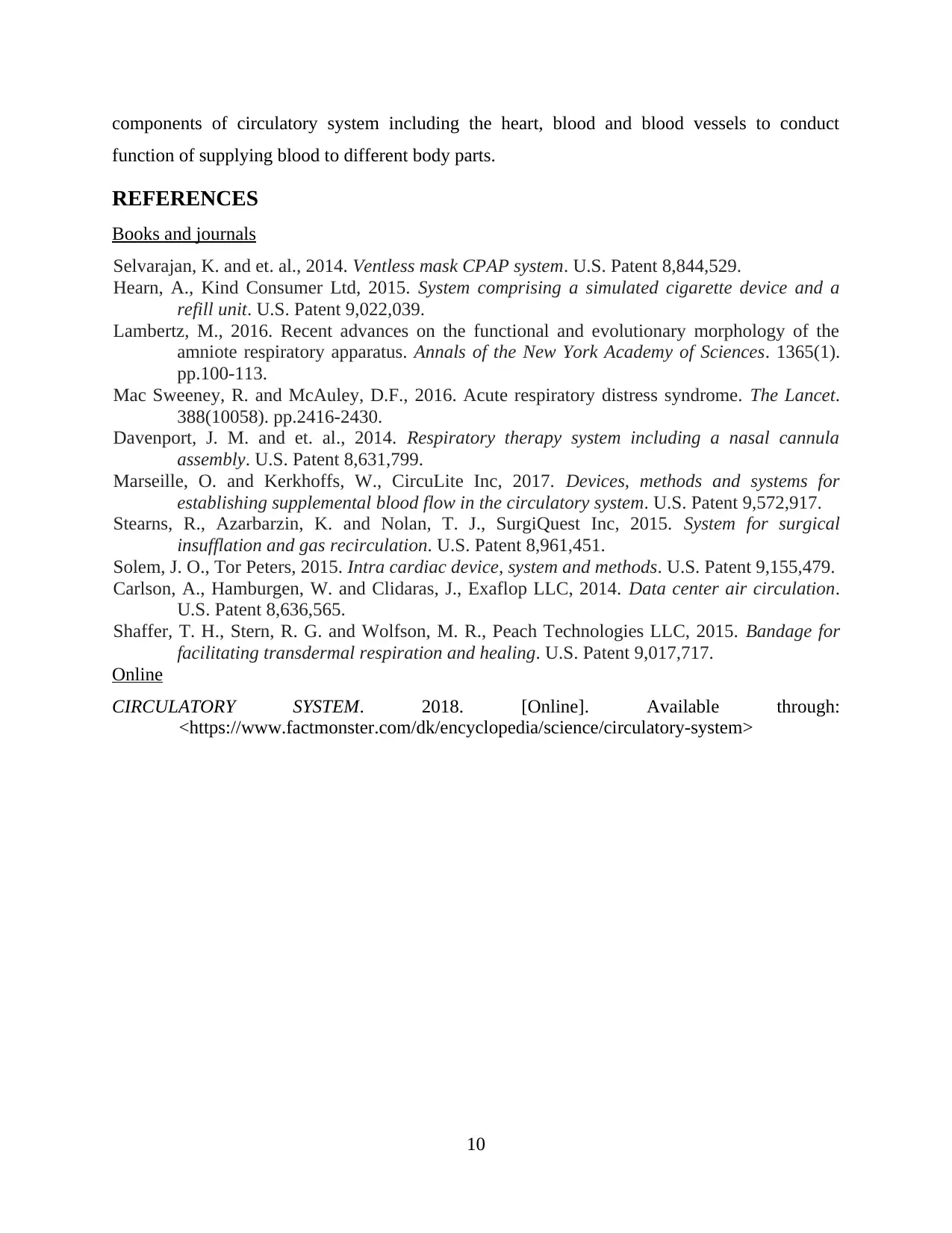
components of circulatory system including the heart, blood and blood vessels to conduct
function of supplying blood to different body parts.
REFERENCES
Books and journals
Selvarajan, K. and et. al., 2014. Ventless mask CPAP system. U.S. Patent 8,844,529.
Hearn, A., Kind Consumer Ltd, 2015. System comprising a simulated cigarette device and a
refill unit. U.S. Patent 9,022,039.
Lambertz, M., 2016. Recent advances on the functional and evolutionary morphology of the
amniote respiratory apparatus. Annals of the New York Academy of Sciences. 1365(1).
pp.100-113.
Mac Sweeney, R. and McAuley, D.F., 2016. Acute respiratory distress syndrome. The Lancet.
388(10058). pp.2416-2430.
Davenport, J. M. and et. al., 2014. Respiratory therapy system including a nasal cannula
assembly. U.S. Patent 8,631,799.
Marseille, O. and Kerkhoffs, W., CircuLite Inc, 2017. Devices, methods and systems for
establishing supplemental blood flow in the circulatory system. U.S. Patent 9,572,917.
Stearns, R., Azarbarzin, K. and Nolan, T. J., SurgiQuest Inc, 2015. System for surgical
insufflation and gas recirculation. U.S. Patent 8,961,451.
Solem, J. O., Tor Peters, 2015. Intra cardiac device, system and methods. U.S. Patent 9,155,479.
Carlson, A., Hamburgen, W. and Clidaras, J., Exaflop LLC, 2014. Data center air circulation.
U.S. Patent 8,636,565.
Shaffer, T. H., Stern, R. G. and Wolfson, M. R., Peach Technologies LLC, 2015. Bandage for
facilitating transdermal respiration and healing. U.S. Patent 9,017,717.
Online
CIRCULATORY SYSTEM. 2018. [Online]. Available through:
<https://www.factmonster.com/dk/encyclopedia/science/circulatory-system>
10
function of supplying blood to different body parts.
REFERENCES
Books and journals
Selvarajan, K. and et. al., 2014. Ventless mask CPAP system. U.S. Patent 8,844,529.
Hearn, A., Kind Consumer Ltd, 2015. System comprising a simulated cigarette device and a
refill unit. U.S. Patent 9,022,039.
Lambertz, M., 2016. Recent advances on the functional and evolutionary morphology of the
amniote respiratory apparatus. Annals of the New York Academy of Sciences. 1365(1).
pp.100-113.
Mac Sweeney, R. and McAuley, D.F., 2016. Acute respiratory distress syndrome. The Lancet.
388(10058). pp.2416-2430.
Davenport, J. M. and et. al., 2014. Respiratory therapy system including a nasal cannula
assembly. U.S. Patent 8,631,799.
Marseille, O. and Kerkhoffs, W., CircuLite Inc, 2017. Devices, methods and systems for
establishing supplemental blood flow in the circulatory system. U.S. Patent 9,572,917.
Stearns, R., Azarbarzin, K. and Nolan, T. J., SurgiQuest Inc, 2015. System for surgical
insufflation and gas recirculation. U.S. Patent 8,961,451.
Solem, J. O., Tor Peters, 2015. Intra cardiac device, system and methods. U.S. Patent 9,155,479.
Carlson, A., Hamburgen, W. and Clidaras, J., Exaflop LLC, 2014. Data center air circulation.
U.S. Patent 8,636,565.
Shaffer, T. H., Stern, R. G. and Wolfson, M. R., Peach Technologies LLC, 2015. Bandage for
facilitating transdermal respiration and healing. U.S. Patent 9,017,717.
Online
CIRCULATORY SYSTEM. 2018. [Online]. Available through:
<https://www.factmonster.com/dk/encyclopedia/science/circulatory-system>
10
1 out of 13
Related Documents
Your All-in-One AI-Powered Toolkit for Academic Success.
+13062052269
info@desklib.com
Available 24*7 on WhatsApp / Email
![[object Object]](/_next/static/media/star-bottom.7253800d.svg)
Unlock your academic potential
© 2024 | Zucol Services PVT LTD | All rights reserved.





